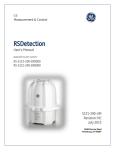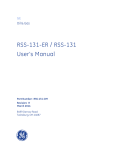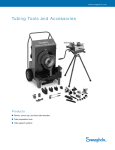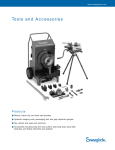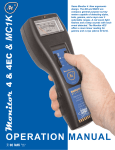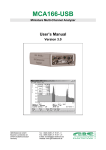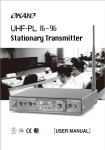Download The Geiger-Mueller Tube, Nuclear Electronics, and Counting Statistics
Transcript
The Geiger-Mueller Tube, Nuclear Electronics, and Counting Statistics GENERAL GOALS: 1. Understand the operation of detectors and electronics used in studying nuclear and high energy physics 2. Understand statistics Reading: q Study the theory of the Geiger-Mueller tube: A.C.Melissinos, Experiments in Modern Physics, p. 175-193 q Study the theory of counting statistics: A.C.Melissinos, Experiments in Modern Physics, p. 438-458, 479-487; P.R.Bevington & D.K.Robinson, Data Reduction and Error Analysis for the Physical Sciences, p. 17-37,53-57 Binomial statistics Poisson statistics Gaussian statistics q Read the handout “An Introduction to Nuclear Electronics” q Study the operation of the oscilloscope, especially the function of various triggering controls q Quickly read about the interaction of radiation with matter: A.C.Melissinos, Experiments in Modern Physics, p. 150174 q Quickly read about radiation safety: A.C.Melissinos, Experiments in Modern Physics, p. 137-149 q Before doing the later part of this experiment, read the handout “COUNTS: A Hardware-Software System for Acquiring Relative Timing Data about Cosmic Rays and Nuclear Events” UNITS USED WHEN DISCUSSING RADIATION See A.C.Melissinos, Experiments in Modern Physics, p.143-147. The curie ( abbreviated Ci) is a measure of the activity of the sample, that is the number of nuclear disintegrations in a given time. Specifically the curie is 3.7 X 1010 disintegrations per second, which is the activity of a gram of radium. In the SI system of units, the curie has been replaced by the becquerel (Bq) with 1 curie = 37 X 109 Bq, so a Bq is 1 disintegration per second. The activity of a source ( in Ci or Bq) is one way to describe the amount of radiation present. An alternative method is to give the flux of radiation. That is the number of quanta ( alpha, beta, gamma, protons, chickens . . . or whatever) incident on a unit area per unit of time ( for example the number of betas incident on 1 cm2 /s ). There is another type of radiation unit, that is related to the interaction of radiation with living tissue. As radiation passes through matter, it interacts and in general deposits energy in the matter. A rad of radiation will deposit 100 ergs of energy for each gram of tissue it passes through. Starting from the activity of a source or the flux of the radiation and converting to rads is not a simple process, because this involves details of the interaction between the specific type of tissue and the specific type and energy of the radiation. Recently SI replaced the rad with the gray (Gy). A gray of radiation will deposit 10,000 ergs of energy for each gram ( or 1 J/kg) of tissue it passes through ( 100 rad = 1 Gy). Even when losing the same amount of energy in a given bit of living tissue, different kinds of radiation cause different degrees of damage. This is because for some type of radiation a given particle may interact relatively infrequently, but given deposit a relatively large amount of energy during each interaction, while a particle of different type of radiation, may interact frequently, but lose only a small amount of energy in each interaction. The energy deposited per gram of tissue may be the same but the damage is different. Thus a further set of units is needed. The rem ( roentgen equivalent unit ( a roentgen is basically 1 rad of gamma’s)) is the standard old unit for radiation damage and the sievert (Sv) is the new SI unit. 100 rem = 1 Sv. The amount of radiation present in Gy, is multiplied by an RBE (relative biological effectiveness) factor to yield the amount of radiation damage in sieverts. The RBE for x rays, gammas and betas is 1, protons it is 10 and for alpha it is 20. Thus the same number of rads or grays of alphas in much more damaging the equivalent amount of gammas. Note the rem or the sievert do not indicate how quickly the damage was done. So often the radiation field is reported in rem/hr or or mrem/ year or Sv/year. Acceptable limits of radiation exposure have decreased over the years as more information on the long term effects of radiation have become available. For the general public the acceptable whole body exposure is 0.1 rem/yr = 1 mSv/yr, while for radiation workers the limit is 5 rem / yr. If the radiation exposure is limited to the skin or extremities the limit is even higher. Typical exposures per year to a member of the public may include: 35-60 mrem from cosmic rays ( strong altitude dependance) 35-70 mrem from natural radioactive sources 30-350 mrem from natural radioactive sources within the body ( 25 from K40, 1 from C14, remainder from Ra226) 100 mrem from medical x-rays. One of our typical “poker chip” sources will produce a radiation field a one meter of about 0.001 mrem/hr. HOMEWORK For this experiment the following sources (found in the white plastic box) were made in June 1995 and each had an activity of 1 ± 0.2 Curie. Isotope half life Cs-137 30.2 years Cd-109 464 days Co-60 5.27 years Ba 133 10.5 years Co-57 271 days Mn-54 313 days Calculate the current activity of these Q1. sources. Also calculate the number of atoms of Cs-137 and the mass of Cs-137 originally contained on the source. What is the flux at a distance of 1 meter Q2. from a 1 Ci source? If you record 1000 counts in one second Q3. in a single measurement, what is your expected uncertainty in this measurement? Relate the parameters that define a given Q4. binomial, Poisson and Guassian distribution various physical ( possibly measurable) values in this experiment. Show that the Gaussian and Poisson Q5. distributions are good approximations of the binomial distribution under certain conditions. Clearly identify these conditions. Are these condition met in this experiment? In the last part of this experiment you Q6. will studying the distribution of random events in time. Derive the expected distribution. INVESTIGATIONS 1. The Geiger Mueller Tube Investigate the effect of varying the voltage applied Geiger-Mueller tube on the size and shape of the pulses from the signal spliter box. Use just the Geiger-Mueller tube, a radioactive source, oscilloscope, pulse signal splitter box, & high voltage power supply. Measure the peak voltage of the pulse, the duration of the pulse, and the overall shape of the pulse as a function of applied voltage. Compare your observations and measurements with the expected operation of the GeigerMueller tube and the associated circuit. Plot the pulse height vs the applied high voltage. Make a semi-log plot. Is there evidence of a plateau region? Pulses of various heights can be observed at a given high voltage setting. Investigate the variations in pulse height as a function of applied high voltage (both absolute and relative pulse height variation). What is the physics of what you are observing? How is the pulse size related to the number of ionized molecules produced in the Geiger-Muller tube by a single high energy particle? What is “dead time”? What is “quenching”? Describe the function of the signal splitter. 2. (have both the AMP OUT and the TCSA OUT displayed on the oscilloscope). Route the output of the TSCA into the counter and figure out how to use the counter. Summarize your investigation of the amplifier/TSCA and counter by writing a one page “user’s manual. Write down all of the setting and make circuit diagrams. 3. The Plateau Curve in Count Rate Investigate the number of counts recorded in a fixed length of time as a function of high voltage applied to the Geiger-Mueller tube. (You can use the Counts program for this part.) Take at least 10 repetitions at each voltage setting. Also observe the variation in the outputs of the AMP and the TSCA as a function of applied high voltage. Plot everything that is changing vs. applied voltage. Consider making semi-log and log-log plots as appropriate. What is the physics of what you are observing? In this experiment, the size of the pulse from the GM tube varies, should you correct this pulse height variation with the amplifier gain before the signal reaches the TSCA? Why or why not? Try measuring the count rate as a function of high voltage applied to the GM tube while keeping the pulse size after the amplifier constant. This would be a measure of the GM relative detection efficiency as a function of applied voltage. Electronics Investigate the effect on the signal for the splitter box, of connecting the amplifier as well as the oscilloscope. Investigate the operation of the amplifier. Describe the effects of various controls on the amplifier’s output ( have both the output of the signal splitter box and AMP OUT displayed on the oscilloscope). Investigate the operation of the TSCA including the effect of changing the various amplifier control settings and the TSCA settings 4. Detection Efficiency What is the current activity of each of the different sources you are using, based of the original activity, the creation date, and the halflives? What fraction of these activities did you detect? How is this related to the overall detection efficiency? Estimate how the geometry of the source and detector effect this efficiency? Is the detections efficiency constant with as the voltage applied to the GM tube is changed? 5. Statistics With the high voltage set to operate the GM tube in the middle of its plateau region, and using a radioactive source, record the number of counts for a fixed time (10-30 seconds). Collect at least 50 data points. Make a histogram of this data set, and graph the appropriately scaled binomial, poisson, and gaussian curves on the histogram. How good is the match for each of these curves Repeat the above procedure, but with the source removed and adjust the counting time so that only a few counts are recorded in each period. What has happened to the agreement between the histogram and the statistical distribution curves, and of course, WHY? From your data above, calculate the probabilities that an event will be recorded within an interval of 10-5 second; an interval of 10-3 second, and an interval of 1 second. What are the probabilities of two events happening within an interval of 10-5 second long, an interval of 10-3 second, and an interval of 1 second. Set the GM high voltage to the middle of the plateau region, and record the number of counts detected in various lengths of time (1 second to 1 minute). For each length of time take enough data (10-50 repetitions) to make a reasonable histogram of the number of events observed. Using this data, calculate the mean number of counts and the standard deviation of the mean for each voltage setting. Then make a log-log plot of standard deviation vs. the mean number of counts. What is the significance of this plot and the slope ( if there is one)? What is the statistical explanation? How does the width of the histogram compare with the standard deviation.. 6. Randomness of Events in Time See A.C.Melissinos, Experiments in Modern Physics, p.189-193, 484-487. Investigate the randomness of events in time from both a radioactive source and background radiation. Many of the background radiation events may be related to cosmic rays. Because one cosmic ray could produce a cascade of particles along its path, it is quite possible that cosmic-ray event could be clustered in time. Use the COUNTS hardware/software system to record a large number ( several thousand events if possible). Plot the time interval between event n-1 and event n against the time interval between event n and event n+1. What is the meaning of this plot? Follow the ideas in A.C.Melissinos, Experiments in Modern Physics ( p.189-193) for further analysis of your data. Plot a histogram of the time separations between events, using various bin widths. Compare with the expected results. 7. Analysis of the Pulse Height (Advanced) Connect the output of the AMP to an MCA. Record the pulse height histogram (spectra) as a function of the voltage applied to the GM tube. In particular, this may provide interesting information when the tube is operating in the proportional counter region. Try comparing the spectra produce when using different radioactive sources. Correlate this with the type and energy of the radiation emitted by the source.




